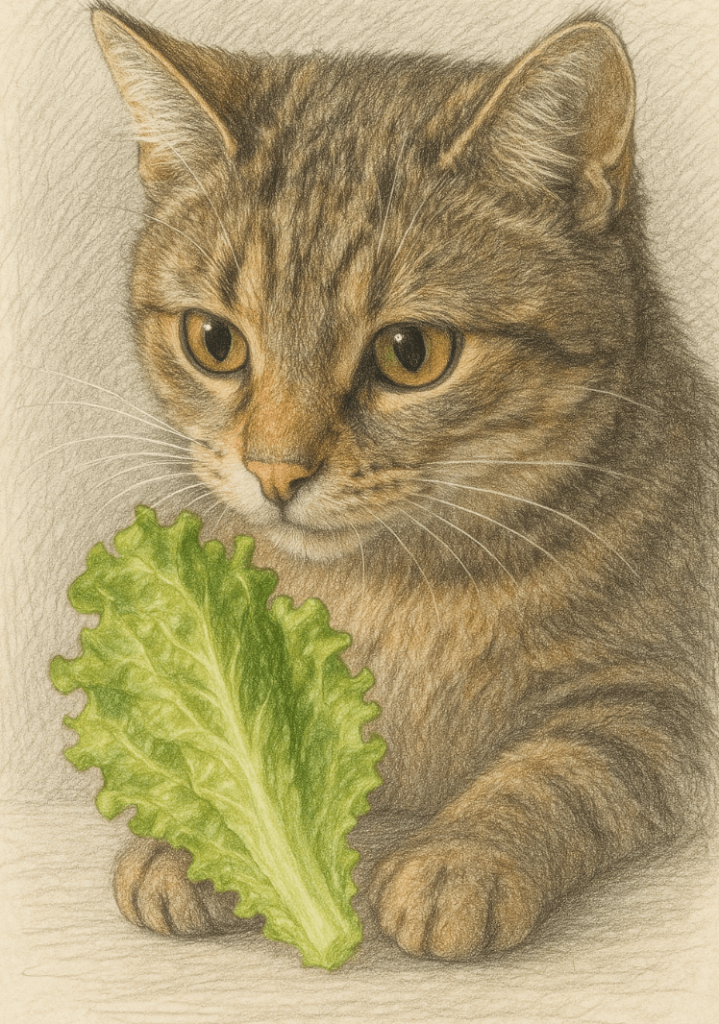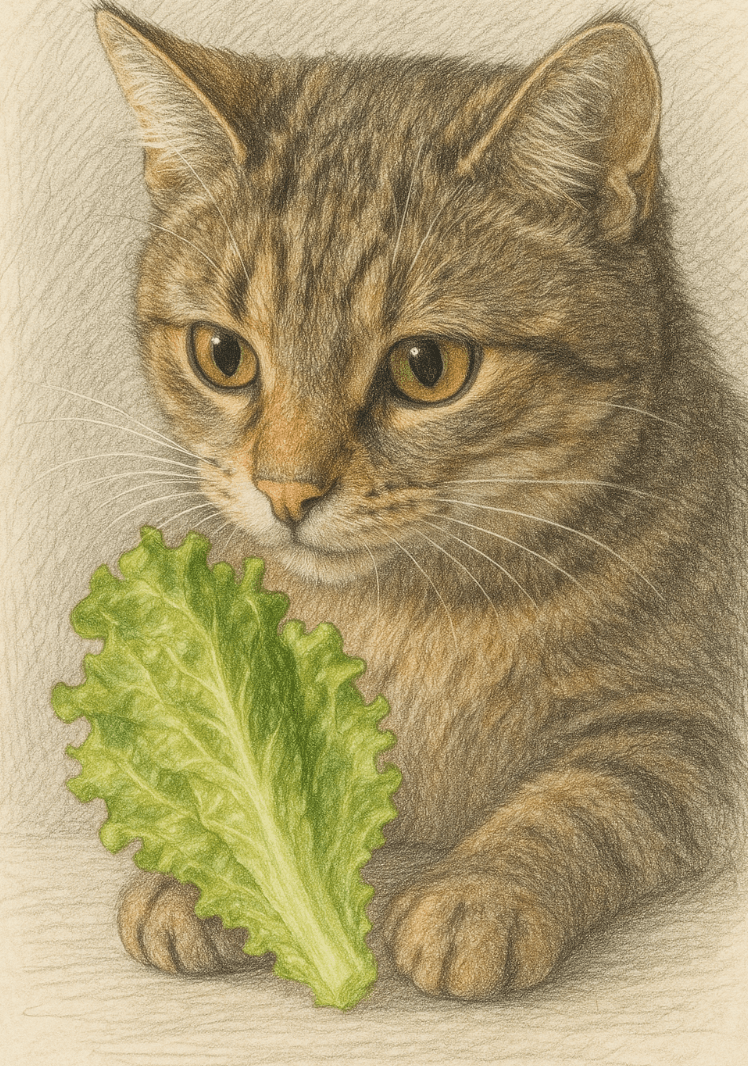Can Cats Eat Lettuce? Everything You Need to Know
Cats are obligate carnivores, meaning their primary diet consists of meat. However, many cat owners wonder if vegetables like lettuce are safe for their feline friends to nibble on. Whether your cat is curious about the greens on your plate or you’re considering adding some variety to their diet, it’s important to understand how lettuce fits into their nutritional needs. While lettuce isn’t toxic to cats, there are factors to consider before offering it as a snack. In this blog post, we’ll explore whether cats can eat lettuce, its potential benefits, risks, and how to introduce it safely into their diet.
Is Lettuce Safe for Cats? Key Points to Consider
Before giving your cat a bite of lettuce, it’s essential to evaluate its safety and suitability for their unique dietary requirements. Here’s what you need to know about feeding lettuce to your feline companion.
Non-Toxic Nature:
Lettuce is not toxic to cats, making it a relatively safe option if offered in moderation.Low Nutritional Value for Cats:
Unlike humans, cats derive little to no nutritional benefit from lettuce since they lack the enzymes to process plant-based foods efficiently.Hydration Benefits:
Leafy greens like romaine lettuce contain water, which can help keep your cat hydrated, especially if they’re reluctant drinkers.Potential Digestive Upset:
Overfeeding lettuce may lead to gastrointestinal issues like diarrhea or vomiting due to its high fiber content.Pesticide Risks:
Always wash lettuce thoroughly to remove pesticides or chemicals that could harm your cat if ingested.
While lettuce isn’t harmful, it should only be given occasionally and in small amounts to avoid any adverse effects.
Types of Lettuce and Their Suitability for Cats
Not all types of lettuce are created equal when it comes to feeding your cat. Some varieties are safer and more suitable than others.
Romaine Lettuce:
Romaine is rich in water and contains vitamins A and K, making it one of the better options for cats if served plain and washed.Iceberg Lettuce:
Iceberg has minimal nutritional value but is still safe in small amounts; however, it offers little benefit beyond hydration.Butterhead Lettuce:
This soft, mild-tasting lettuce is easy to chew and digest, making it a good choice if introduced gradually.Avoid Seasoned or Topped Lettuce:
Lettuce with dressings, oils, or spices can upset your cat’s stomach and should always be avoided.Skip Wild or Bitter Greens:
Varieties like arugula or kale may be too strong or difficult for cats to digest, so stick to milder options.
Choosing the right type of lettuce ensures your cat enjoys a safe and palatable experience.
Check this guide 👉Can Dogs Eat Kangaroo Meat? Best 7 Expert Tips!
Check this guide 👉Can Dogs Eat Without Teeth? Best 7 Expert Tips!
Check this guide 👉Can Dogs Eat Toffee? Best 7 Expert Tips!

Benefits of Feeding Lettuce to Cats | Risks of Feeding Lettuce to Cats |
|---|---|
Provides additional hydration | Can cause digestive upset in large amounts |
Low-calorie snack option | May contain harmful pesticides if unwashed |
Encourages curiosity with new textures | Offers minimal nutritional value |
Helps alleviate occasional constipation | Risk of choking if not chopped finely |
Non-toxic and safe in moderation | Not a substitute for a balanced diet |
How to Safely Introduce Lettuce to Your Cat
If you decide to offer lettuce to your cat, it’s important to do so carefully to ensure their safety and comfort. Follow these guidelines for a smooth introduction.
Start Small:
Begin with a tiny piece of lettuce to see how your cat reacts before offering more.Wash Thoroughly:
Rinse the lettuce under running water to remove dirt, pesticides, or contaminants that could harm your pet.Serve Plain Only:
Avoid adding seasonings, oils, or dressings, as these can irritate your cat’s digestive system.Chop into Bite-Sized Pieces:
Cutting the lettuce into small, manageable pieces reduces the risk of choking.Monitor for Reactions:
Watch for signs of discomfort, such as vomiting or diarrhea, after your cat tries lettuce for the first time.
By following these steps, you can minimize risks while introducing a new food to your cat’s routine.
Signs Your Cat May Not Tolerate Lettuce Well
While most cats tolerate small amounts of lettuce without issue, some may experience adverse reactions. Recognizing these signs allows you to act quickly if something goes wrong.
Vomiting or Regurgitation:
If your cat vomits shortly after eating lettuce, it may indicate an intolerance or sensitivity.Diarrhea or Loose Stools:
Excessive fiber from lettuce can disrupt your cat’s digestion, leading to loose stools.Loss of Appetite:
Refusal to eat regular meals after trying lettuce could signal digestive discomfort.Lethargy or Discomfort:
A sudden drop in energy levels might suggest that the lettuce didn’t agree with your cat.Excessive Drooling:
Drooling can occur if your cat finds the texture unpleasant or struggles to swallow.
If any of these symptoms persist, consult your veterinarian to rule out underlying issues.
Common Mistakes to Avoid When Feeding Lettuce to Cats
Feeding lettuce to your cat requires attention to detail to avoid mistakes that could harm their health. Here are some pitfalls to watch out for.
Offering Too Much at Once:
Large portions can overwhelm your cat’s digestive system, leading to discomfort or illness.Neglecting to Wash the Lettuce:
Unwashed lettuce may carry pesticides or bacteria that pose risks to your cat’s health.Adding Harmful Ingredients:
Dressings, oils, or spices can irritate your cat’s stomach and should always be avoided.Ignoring Allergic Reactions:
Failing to monitor for signs of allergies or sensitivities can delay treatment if complications arise.Using Lettuce as a Staple Food:
Lettuce lacks the protein and nutrients cats need, so it should never replace their main diet.
Avoiding these mistakes ensures a safer and healthier experience for your cat.
Alternative Vegetables Safe for Cats
If your cat shows interest in greens but doesn’t seem to enjoy lettuce, there are other vegetables you can try that offer greater nutritional value.
Steamed Carrots:
Rich in beta-carotene, steamed carrots are easy to digest and provide antioxidants beneficial for cats.Plain Pumpkin Puree:
Canned pumpkin (unsweetened) aids digestion and helps regulate bowel movements in cats.Green Beans:
Low in calories and high in fiber, green beans make a healthy snack when served plain and cooked.Zucchini:
Soft and mild-flavored, zucchini is a safe vegetable that most cats tolerate well.Peas:
High in protein and vitamins, peas can be offered in moderation as part of a varied diet.
These alternatives provide a wider range of nutrients while catering to your cat’s natural curiosity.
Fun Ways to Incorporate Lettuce into Your Cat’s Routine
If your cat enjoys lettuce, there are creative ways to include it in their diet while keeping things interesting.
Mix with Wet Food:
Chop lettuce finely and mix it into your cat’s wet food for added texture and hydration.Freeze in Ice Cubes:
Blend lettuce with water and freeze it into cubes for a refreshing summer treat.Create a “Snack Bar”:
Place small pieces of lettuce alongside other safe veggies like steamed carrots for a DIY tasting session.Use as a Training Reward:
Offer tiny bits of lettuce as a low-calorie reward during training sessions.Encourage Play Before Eating:
Scatter small lettuce pieces around the room to stimulate your cat’s hunting instincts before mealtime.
These ideas add variety and fun to your cat’s routine while incorporating safe, healthy snacks like lettuce.
Frequently Asked Questions About Cats and Lettuce
Can kittens eat lettuce?
Yes, but only in very small amounts and under supervision, as their digestive systems are still developing.
How often can I give my cat lettuce?
Once or twice a week at most, ensuring it doesn’t replace their primary diet of meat-based foods.
What happens if my cat eats too much lettuce?
Overconsumption can lead to digestive upset, including vomiting, diarrhea, or bloating.
Should I cook lettuce before giving it to my cat?
No, raw lettuce is safer and easier for cats to digest compared to cooked versions, which may lose nutrients.
Are there better vegetables for cats than lettuce?
Yes, options like steamed carrots (in moderation) or pumpkin puree provide more nutritional benefits for cats.
Balancing Curiosity and Nutrition for Your Cat
While cats can eat lettuce safely in moderation, it’s important to remember that their bodies are designed for a meat-based diet. Lettuce can serve as an occasional treat or a way to encourage hydration, but it shouldn’t replace their primary source of nutrition. By understanding your cat’s dietary needs and monitoring their reactions, you can confidently introduce new foods like lettuce without compromising their health. Ultimately, the key is balance—ensuring your feline friend enjoys variety while staying nourished and happy.
Cat Fever Treatment: Best 7 Expert Tips! Discover expert advice on identifying, managing, and treating fever in cats to ensure their quick recovery and well-being.
Understanding Meloxicam for Cats: Best 7 Expert Tips! Learn how to safely administer meloxicam, manage side effects, and ensure your cat's comfort with expert advice on feline pain relief.
Amoxicillin for Cat UTI: Best 7 Expert Tips! Discover safe usage, dosage guidelines, and expert advice on treating feline urinary tract infections effectively with amoxicillin.
Understanding Cat Cancer Treatment: Best 7 Expert Tips! Discover expert advice on managing feline cancer, from early detection to treatment options, ensuring your cat’s health and comfort.





